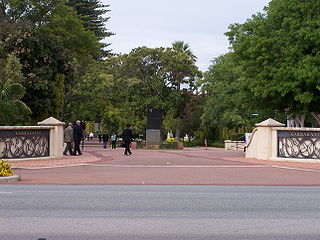
Ballarat is a city in the Central Highlands of Victoria, Australia. At the 2021 Census, Ballarat had a population of 116,201, making it the third largest city in Victoria.

The Eureka Rebellion was a series of events involving gold miners who revolted against the British administration of the colony of Victoria, Australia during the Victorian gold rush. It culminated in the Battle of the Eureka Stockade, which took place on 3 December 1854 at Ballarat between the rebels and the colonial forces of Australia. The fighting resulted in an official total of 27 deaths and many injuries, the majority of casualties being rebels. There was a preceding period beginning in 1851 of peaceful demonstrations and civil disobedience on the Victorian goldfields. The miners had various grievances, chiefly the cost of mining permits and the officious way the system was enforced.

The Victorian gold rush was a period in the history of Victoria, Australia approximately between 1851 and the late 1860s. It led to a period of extreme prosperity for the Australian colony, and an influx of population growth and financial capital for Melbourne, which was dubbed "Marvellous Melbourne" as a result of the procurement of wealth.

Peter Fintan Lalor was an Irish-Australian rebel and, later, politician who rose to fame for his leading role in the Eureka Rebellion, an event identified with the "birth of democracy" in Australia.

Avoca is a town in the Central Highlands of Victoria, Australia, 71 kilometres (44 mi) north west of Ballarat. It is one of two main towns in the Pyrenees Shire, the other being Beaufort to the south.
John Basson Humffray was a leading advocate in the movement of miner reform process in the British colony of Victoria, and later a member of parliament.

Henry Ross was a Canadian-Australian gold miner who died in the Eureka Rebellion at the Ballarat gold fields in the British Colony of Victoria, now the state of Victoria in Australia. Ross is particularly remembered for his part in the creation of the rebel miners' flag, since named the Eureka Flag.

The Melbourne General Cemetery is a large necropolis located 3 km (1.9 mi) north of the city of Melbourne in the suburb of Carlton North.

Ballarat East is a suburb of Ballarat in Victoria, Australia. From 1857 until 1921 the suburb had its own council. The suburb covers a large area east of the city centre. It is the oldest urban area in Ballarat and was the site of many goldmines, as well as of the Eureka Rebellion.

Karrakatta Cemetery is a metropolitan cemetery in the suburb of Karrakatta in Perth, Western Australia. Karrakatta Cemetery first opened for burials in 1899, the first being that of wheelwright Robert Creighton. Managed by the Metropolitan Cemeteries Board, the cemetery attracts more than one million visitors each year. Cypress trees located near the main entrance are a hallmark of Karrakatta Cemetery. The cemetery contains a crematorium, and in 1995 Western Australia's first mausoleum opened at the site.
The Ballarat Reform League came into being in October 1853 and was officially constituted on 11 November 1854 at a mass meeting of miners in Ballarat, Victoria to protest against the Victorian government's mining policy and administration of the goldfields.
James Scobie was a Scottish gold digger murdered at Ballarat, Victoria, Australia. His death was associated with a sequence of events which led to the Eureka Rebellion.

Michael Paul Nunan, CFC was a member of the Congregation of Christian Brothers and an influential educationalist in New Zealand, Victoria and, especially, Western Australia.
William James McAdam was an Australian politician.
Coburg Pine Ridge Cemetery is located in the northern Melbourne suburb of Preston, Victoria, Australia. The main entrance is on Bell Street, Preston. The Cemetery is managed by Greater Metropolitan Cemeteries Trust (GMCT), and work closely with local community group, Friends of Coburg.

St Thomas Rest Park, located in West Street, Crows Nest, New South Wales is the site of the first cemetery on Sydney's North Shore. It is the largest park in the densely populated Crows Nest area.

The Battle of the Eureka Stockade was fought in Ballarat, Victoria, on 3 December 1854, between gold miners and the colonial forces of Australia. It was the culmination of the 1851-1854 Eureka Rebellion during the Victorian gold rush. The fighting resulted in an official total of 27 deaths and many injuries, the majority of casualties being rebels. The miners had various grievances, chiefly the cost of mining permits and the officious way the system was enforced.
Ballaarat New Cemetery is a cemetery located in the rural city of Ballarat, Victoria in Australia. The cemetery dates back to 1867.

Trelawny is a gracious heritage house located at 804 Havelock Street, Black Hill, a suburb of the Victorian gold rush city of Ballarat, Victoria, Australia. Havelock Street, the street where Trelawny is located, was named in recognition of Major General Sir Henry Havelock, a British general who is particularly associated with India and the Indian Mutiny of 1857.
Alfred Ronalds was an English author, artisan and Australian pioneer, best known for his book The Fly-fisher's Entomology.











